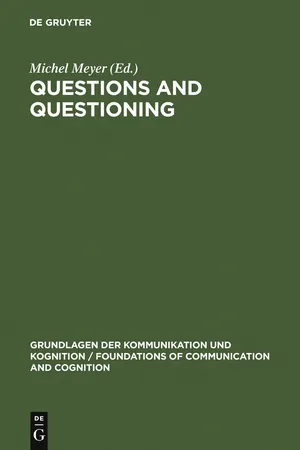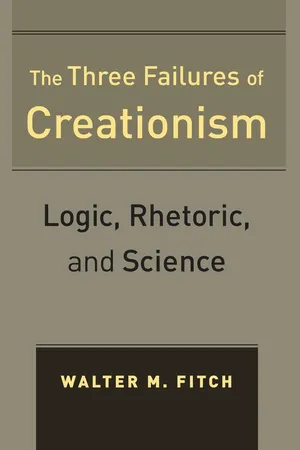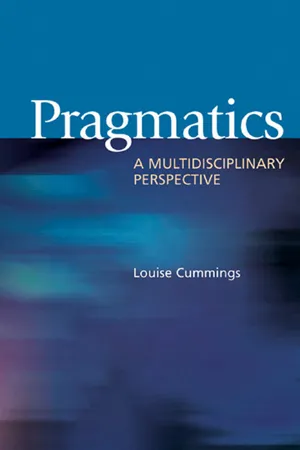Languages & Linguistics
Begging the Question
"Begging the question" is a logical fallacy where the conclusion of an argument is assumed within the premises. In other words, it occurs when someone's argument assumes the truth of the conclusion they are trying to prove. This circular reasoning can make an argument seem valid when it is actually flawed.
Written by Perlego with AI-assistance
Related key terms
1 of 5
5 Key excerpts on "Begging the Question"
- eBook - PDF
- Scott Stanley(Author)
- 2020(Publication Date)
- Society Publishing(Publisher)
The phrase Begging the Question is a literal translation of the term ‘ petitio principii’ which refers to the practice of begging the audience to grant the truth of claim as a premise. However, in reality the arguer is either asking a claim which us identical to or presupposes the truth of the conclusion which the arguer is trying to make. In essence, the arguer is arguing in a circle. One reason he offers in support of the conclusion is the conclusion itself. It is an illicit presumption where the proposition that is the assumption is the same proposition that the arguer is trying to demonstrate. An example is: Gods do exist, because the religious texts say so. The religious texts are true because Gods have written them. The argument that Gods have written the religious texts assumes that gods exists. This way it begs the question. The argument that begs the question can be formally valid. However, it does not support the truth of its conclu-sion. An argument that begs the question will be rejected by a person who does not accept the truth of the conclusion. 6.5.2. Complex Question In this fallacy, the arguer demands a single answer to a complex question. The arguer seeks to deceive by demanding a single answer to a complex question which needs multiple answers. Therefore, it is also referred to as fallacy of many questions. The questions are loaded, which is the very asking of which presumes the truth of a claim. This is often used in debates, where a controversial claim is sneaked into the discussion without asserting it evidently. Yes or no questions are strategically used in effective debating technique. When an opponent is caught off-guard, they will not be able to answer in a simple yes or no as it would commit them to truth of illicit presumption. This is not something they want to accept. Their struggle in responding will make them look evasive. The arguer uses this opportunity to further attack the opponent. - eBook - PDF
- Michel Meyer(Author)
- 2011(Publication Date)
- De Gruyter(Publisher)
15 See Walton (1982) for a study of the concept of a question at issue. Question-Asking Fallacies 205 interrogative type of move in dialogue. The question at issue refers to the proposition to be established. So construed, Begging the Question is not a fallacy of question-asking. It is a species of failure to prove the proposition to be established. 16 The question is begged, so to speak, because the proposition to be proved is not really proved at all, but only presumed by the premises of the argument. Depending on how the fallacy of Begging the Question is construed then, its connection with fallacies of question-asking may be less intimate than the traditional terminology suggests. The more important connection here may reside in the observation often made in logic textbooks that some instances of the complex question fallacy involve what are called question-begging epithets. A question-begging epithet is a prejudicial term (epithet) that can be used in a premise of an argument to stack the argument unfairly against the position of the respondent to whom the argument is directed. The classic example is one said to have originated from Jeremy Bentham. Example 10: This doctrine is heresy. Therefore this doctrine should be condemned. This argument is said to beg the question because (i) although the argument may be valid — if the doctrine is truly heresy then it should be condemned — (ii) the respondent to whom the argument is directed, presuming, in the context of dialogue, his thesis is that this doctrine should not be condemned, will not accept the premise that the doctrine is heretical. Why would he not accept it? Presumably because it is so clear that if he does, it directly follows that his side of the argument is refuted. Moreover, if his position is that the doctrine should not be condemned, he is not too likely to be committed to the proposition that the doctrine is heretical. - eBook - PDF
The Three Failures of Creationism
Logic, Rhetoric, and Science
- Walter Fitch(Author)
- 2012(Publication Date)
- University of California Press(Publisher)
d. logical fallacies 1. Begging the Question (circularity): assuming the conclusion you wish to reach. 10 / Logic, Logical Fallacies, and Rhetoric A circular argument does not advance our knowledge beyond what was already known or assumed in the premises. That is, the argument being presented begs us to ask the question, What is the support for the premises? Or, What do the premises have to do with the conclusion? Consider the following syllogism: Premise 1: Complex things can be produced only by a designer. Premise 2: The human eye is a complex thing. Conclusion: The eye must have been designed. Are we sure of the first premise? Is it really true that the only way a complex thing can come into being is by the work of a con-scious designer? Or consider how Begging the Question may be used in politi-cal speech: Premise 1: Smith is a good family man. Premise 2: Smith was a great football player. Conclusion: Smith will make a good mayor. We must ask what the premises have to do with the conclusion. Unless you feel that being a good family man or a great football player somehow builds your character or prepares you for politi-cal offi ce, the premises have nothing to do with the conclusion. 2. The equivocation fallacy (also called a category error ): using a word with two different meanings in the same argument. Examples of the equivocation fallacy are given below. A par-ticularly obvious example is the following. First read down the left half of the syllogism to get the silly conclusion that is clearly wrong. Logic, Logical Fallacies, and Rhetoric / 11 Silly Correct Premise 1: I am a nobody. I am a person of no importance. Premise 2: Nobody is perfect. There is no individual that is perfect. Conclusion: I am perfect. (No logical conclusion possible.) Now read the syllogism again utilizing the phrasings on the right for the word nobody. - eBook - ePub
Pragmatics
A Multidisciplinary Perspective
- Louise Cummings(Author)
- 2013(Publication Date)
- Routledge(Publisher)
A System of Logistic, Alfred North Whitehead remarks: ‘In the modern development of Logic, the traditional Aristotelian Logic takes its place as a simplification of the problem presented by the subject. In this there is an analogy to arithmetic of primitive tribes compared to modern mathematics’ (1934).14 . The result of the development of mathematical-logical calculi by Frege and Russell.15 . ‘Argument A is circular or begs the question if and only if A contains premise P and conclusion C, and P presupposes C. P presupposes C if and only if it is not justified to believe P unless it is justified to believe C’ (Jacquette 1993: 322).16 . Begging the Question, and a number of other fallacies besides, can be variously characterised as epistemic or dialectical fallacies, depending on whether an arguer is related to the propositions of an argument through knowledge (epistemic fallacy) or acceptance (dialectical fallacy).17 . A primary impetus for the development of formal logic was the desire to rid logic of its dependence on the subjective judgements of individual reasoners: ‘the present day methodology endeavours to replace subjective valuations in the examination of definitions and proofs by criteria of an objective nature, and to make the decision as to the correctness of definitions or proofs dependent exclusively upon their structure, that is, their exterior form’ (Tarski 1965: 132).18 . Barth identifies a number of earlier sources with a similar dialogical emphasis. One of these sources is a book written by Arne Naess – En del elementaere logiske emner (Some elementary topics in logic) – in the 1940s. In addition to Naess’s work, Barth identifies three other earlier works: ‘In 1959 another event took place which changes the situation at least in principle: the birth of Paul Lorenzen’s dialogue approach to first-order predicate logic (“elementary formal logic”). This was preceded by E.W. Beth’s method of semantic tableaux in 1955, followed by his (Beth’s) method of deductive tableaux (1959)’ (1982: 4).19 - eBook - PDF
Critical Thinking
A User's Manual
- Debra Jackson, Paul Newberry(Authors)
- 2015(Publication Date)
- Cengage Learning EMEA(Publisher)
All Rights Reserved. May not be copied, scanned, or duplicated, in whole or in part. Due to electronic rights, some third party content may be suppressed from the eBook and/or eChapter(s). Editorial review has deemed that any suppressed content does not materially affect the overall learning experience. Cengage Learning reserves the right to remove additional content at any time if subsequent rights restrictions require it. 256 Chapter 11 Hint! Fallacies are often sorted into two main types: formal and informal. A for-mal fallacy is a mistake in the logical structure of an argument that renders it invalid. An informal fallacy is a mistake arising from the content rather than the structure of the argument. Frequently, such mistakes are due to the use of ambiguous language or irrelevant premises. The six fallacies introduced in this chapter are all informal fallacies. L E A R N I N G O U T C O M E S In this chapter, you will learn how to detect fallacies by: f Recognizing the Begging the Question fallacy, f Recognizing the appeal to ignorance fallacy, f Recognizing the appeal to illegitimate authority fallacy, f Recognizing the ad hominem fallacy, f Recognizing the strawman fallacy, f Recognizing the red herring fallacy, and f Writing a Critical Précis of a fallacious argument. Begging the Question The fallacy of Begging the Question occurs when the conclusion of an argument is assumed by the argument’s premises. Although technically the conclusion of such an argument must follow if the premises are true (after all, the conclusion is in the prem-ises), an argument that begs the question isn’t much of an argument at all. It states, in effect, that “some claim is true because that claim is true.” This kind of argument is fallacious because it offers no evidence for its conclusion. The premise doesn’t offer a reason to accept the truth of the conclusion; it merely restates it.
Index pages curate the most relevant extracts from our library of academic textbooks. They’ve been created using an in-house natural language model (NLM), each adding context and meaning to key research topics.




